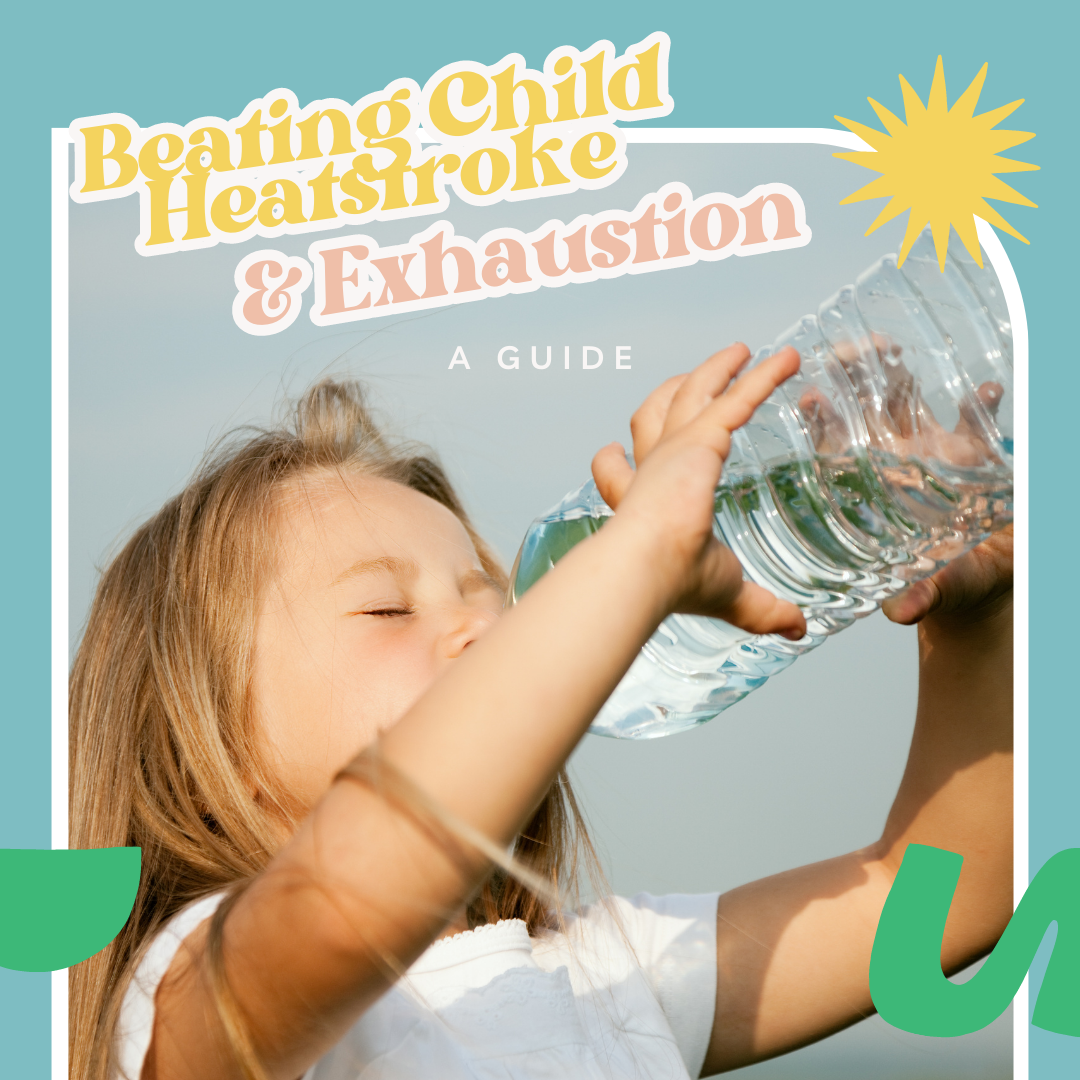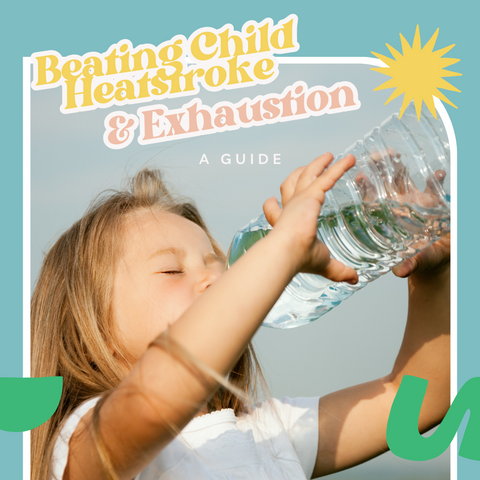
Understanding and Combating Heat Exhaustion and Heatstroke in Children
Disclaimer: This article is intended to provide general information and awareness about heat exhaustion and heatstroke in children. It is not intended to replace professional medical advice, diagnosis, or treatment. Always seek the advice of your physician or other qualified health provider with any questions you may have regarding a medical condition. In case of an emergency, please call your local emergency number immediately. Never disregard professional medical advice or delay in seeking it because of something you have read in this article.
Picture a scorching summer day. Your child is out playing, but you can’t shake off this nagging feeling.
The heat is no joke and your little one’s body is more vulnerable than you think. 
Do you know how to tell when it’s all too much for them? And what to do if things take a turn for the worse?
In this article, you'll unlock the secrets to guarding your child against heat exhaustion and heatstroke, and learn the all-important steps to take if they're under the weather.
Understanding Heat-Related Illnesses
Heat-related illnesses creep up when the body's usual cooling system just can’t cope with the external temperatures.
There are two main culprits you need to be on the lookout for heat exhaustion and heatstroke.
Heat Exhaustion
This is the sneakier of the two. It can spring up slowly but can turn into heatstroke if not addressed.
Your child’s body struggles to cool down. If this sounds all too familiar, don't panic, we'll cover what to do shortly.
Heatstroke
This is the big bad boss. It requires immediate action as it means your child’s body is overheating seriously.
This could harm their vital organs if not treated right away.
Identifying the Warning Signs
Wouldn't it be a lifesaver to know what signs to keep an eye on? Well, here’s your checklist.
Signs of Heat Exhaustion
- Tiredness, like they’ve run a marathon.
- Dizziness, almost like they're on a merry-go-round.
- Headache, akin to a drum beating in their head.
- Nausea or vomiting.
- Sweating with pale, clammy skin or a heat rash.
- Cramps in arms, legs, or stomach.
Related: How to Use Calming Music To Help Your Kids Sleep Better
Signs of Heatstroke
- Dizziness or confusion, as if they’re in a haze.
- Lethargy or unresponsiveness.
- Restlessness, like a cat on a hot tin roof.
- Vomiting.
- Feeling like a hot water bottle to the touch, especially around the neck and ears.
- Rapid, shallow breathing.
- Strong heartbeat, like a ticking clock.
- Dry skin when it should be sweaty.
- Refusing to eat or drink.
Quick Actions to Save the Day
You’ve spotted the signs, now what?
When Heat Exhaustion Strikes
- Bring them to a cooler place. It's like giving a wilting plant some shade.
- Hydrate with cool water or electrolyte drinks. Consider it watering the plant.
- Strip them off unnecessary clothing. Think of it as removing a winter coat in the height of summer.
- Apply cool water to their skin. It’s like giving them a refreshing rain shower.
- Encourage them to rest. Like hitting the snooze button on a busy day.
Battling Heatstroke
- Move them to a cool area. Stat!
- Ventilate by opening windows or using a fan. Think of it as inviting a cool breeze in.
- Don't give medication like aspirin or paracetamol.
- If they're hard to wake up, act confused, have a seizure, show signs of shock, or have a fever over 105°F (40.5°C), call 999 immediately. This is a red alert.
Understanding the Risk Factors
Certain factors can increase a child's risk of suffering from heat exhaustion or heatstroke.
These include:
- Age: Younger children, especially those under four years old, are at a higher risk because their bodies can't regulate temperature as efficiently.
- Health: Existing health conditions, such as heart, lung, or kidney diseases, or any condition that causes dehydration can make them more susceptible.
- Activity: Engaging in intense physical activity in hot weather can accelerate the onset of heat-related illnesses.
The Golden Rules of Prevention
You can't go wrong if you stick to these rules:
- Hydrate. Then hydrate some more.
- Dress them in lightweight and light-coloured clothing.
- Plan their day to avoid the peak sun hours.
Empowering Children: Teach Them the Signs
Part of protecting our children is teaching them to protect themselves.
Older children can be taught to recognise the signs of heat exhaustion and heatstroke:
- Explain to them how they might feel.
- Reinforce the importance of taking breaks in the shade, especially if they feel any of the warning signs.
- Remind them about the importance of staying hydrated and avoiding overly strenuous activities during peak heat hours.
- Assure them it's okay to stop and rest if they're feeling unwell, even if their friends are still playing.
Remember, children imitate adult behaviour. Show them that you also follow these guidelines and explain why they are important.
This could be a vital step in helping them develop good habits in managing heat and understanding their bodies.
Recovery and Aftercare
After suffering from heat exhaustion or heatstroke, your child needs ample rest to recover fully.
Ensuring they're rehydrated is vital, and they should avoid strenuous activity and exposure to hot conditions for at least a week following the incident.
If symptoms persist or you have concerns about their recovery, consult a healthcare professional.
Remember, it's always better to prevent heat-related illnesses where possible.
Stay vigilant, understand the risks, and help your child enjoy the warmer months safely.
The British Red Cross Baby and Child First Aid App
Need more help? The British Red Cross has an app filled with tips and advice about keeping your child safe in hot weather.
It's like having a tiny guardian angel in your pocket.
In Summary: Be the Lifeguard in the Scorching Heat
In a nutshell, your child relies on you to be their lifeguard in the sweltering heat.
So, arm yourself with this knowledge and be ready to dive in if the heat tries to spoil the fun.
Because nothing should stand in the way of your child enjoying a summer's day!
FAQs
What should I pack in my child's bag for a day out in the sun?
When packing for a day out in the sun, include plenty of water for hydration and snacks that can also provide hydration, like fruits. Pack light-coloured and lightweight clothing, plus a hat for shade. Don't forget the sunscreen to protect your skin from UV rays. It might also be beneficial to pack a small towel that can be wet and used to cool them down if necessary.
How does humidity impact the risk of heat-related illnesses?
High humidity can increase the risk of heat-related illnesses. When the humidity is high, sweat doesn't evaporate as quickly, which prevents the body from releasing heat as effectively. This can lead to an increased body temperature and the potential for heat exhaustion or heatstroke. On days with high humidity, it's even more critical to ensure your child stays hydrated and cool.
How can I help my child recover after a heat-related illness?
After a heat-related illness, it's important to allow your child to rest and rehydrate. They should stay in a cool place and avoid strenuous activities, especially those in the sun, for at least a few days to give the body a chance to recover. If symptoms persist or you're concerned about your child's recovery, you should consult a healthcare professional.
